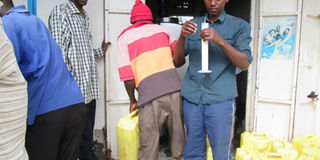Lyantonde dairy farmers get new market for milk

Collection centre. A dealer tests the quality of milk at one of dairy cooperative centres in Lyantonde District on January 29, 2019. PHOTO BY PAUL SSEKANDI
What you need to know:
- Mr Fred Muhangi ,the Lyantonde District chairperson, asked government to build dairy farmers’ capacity to add value to their milk as this will help farmers generate more income.
Dairy farmers in Lyantonde District can now breathe a sigh of relief after getting another company to buy their milk.
This comes nearly a month after the principal milk buyer, Pearl Dairy Farms Ltd, suspended operations in the district.
Mr Yosia Bagabo, the chairperson of Kabula Farmers’ Cooperative Society, said they have negotiated a new deal with Amos Dairies Ltd located in Kiruhura District.
“When Pearl Dairy Farms Ltd suspended their operations in Lyantonde, farmers started pouring away their milk because no one was taking it, we made huge losses. But we are now happy for this deal with Amos Dairies because we can sell a litre of milk at Shs600 and the cooperative retains Shs100 to run its activities,” he said during an interview on Thursday.
However, Mr Bagabo said Shs600 for a litre of milk is too low compared to Shs1,200 it sold at last year.
“But we have nothing to do because the buyer determines the price,’’ Mr Bagabo said.
Issue
Early last month, the Kenyan authorities confiscated and later returned trucks of Lato Milk produced by Pearl Dairy Farms Limited, claiming the product was sub-standard.
This affected the company’s production capacity at home forcing it to stop receiving milk from some of its suppliers.
Kenya had earlier said it would impose a 16 per cent Value Added Tax on the milk products.
According to Uganda Revenue Authority, at least 19 truck-load of milk worth more than Shs1 billion were returned to Uganda even after being cleared by the government bodies for distribution in Kenya.
Mr Bagabo said as a cooperative society, they have registered a loss of Shs504m ever since Pearl Dairy Farms Ltd stopped buying their milk. “When Pearl Dairy Farms Ltd stopped buying our milk, we got stuck with a total of 840,000 litres of milk for two weeks and we could not make any money ,” he said.
Milk from the cooperative was sold to Pearl Dairy Farms Ltd without being processed.
In Lyantonde, Mr Bagabo said the cooperative society with 600 dairy farmers collects more than 50,000 litres of milk daily during dry spells and about 70,000 litres during rainy season, making it the leading dairy cooperative society in the district.
Other cooperative societies are Twimukye Dairy Farmers in Kasagama Sub-county and Kyenshama Dairy Farmers.
A top manager at Pearl Dairy Farms Ltd, who preferred anonymity, said the company temporarily pulled out of Lyantonde but will resume normal operations soon .
“It is true we pulled out of Lyantonde for the time being but we are looking into the matter,” the manager said by telephone yesterday.
Mr Gordon Mugimba, a dairy farmer from Kaliiro Sub-county, asked government to come to their rescue and help them meet the raising costs of maintaining dairy cows.
“We need a stable and ready market where we sell our milk, government should speed up efforts to stabilise milk prices. Some of my children have not yet gone to school because the little money we earn is spent on buying drugs to treat animals,’’ Mr Mugimba said.
Appeal to government
Mr Fred Muhangi ,the Lyantonde District chairperson, asked government to build dairy farmers’ capacity to add value to their milk as this will help farmers generate more income.
“We have a lot of milk in the district, let government empower farmers with machines that add value to milk to boost their bargaining power on an international market,’’ Mr Muhangi said.
He said the district budget is largely supported by dairy farmers and anything that cripples their business affects them too.
Statistics
Involved. The National Population & Housing Census, 2014 indicates that out of the total population of 93,753 people in Lyantonde District, 11,806 (57.2 per cent) are engaged in livestock farming, while 16,383 (79.4 per cent) are growing crops.




